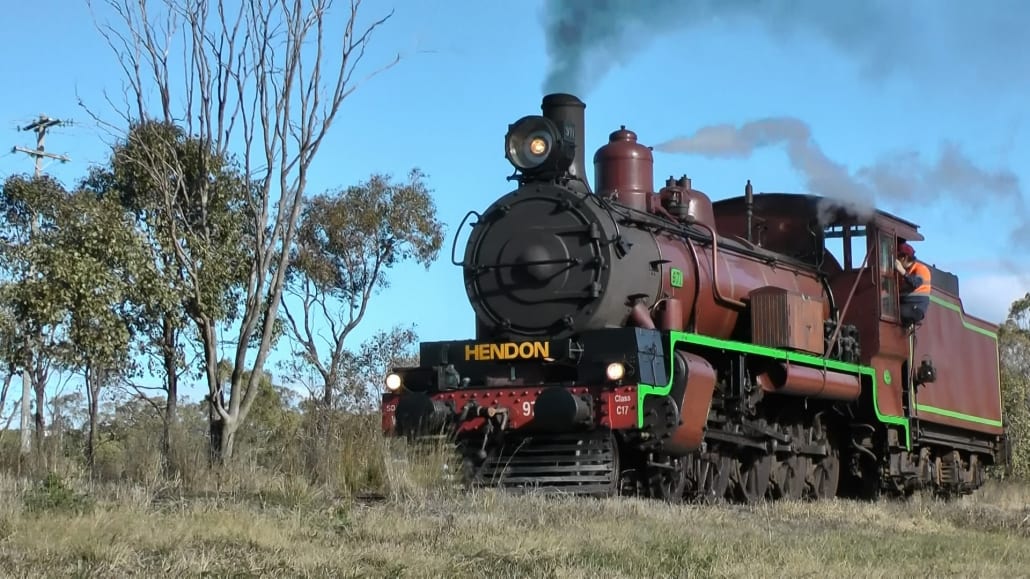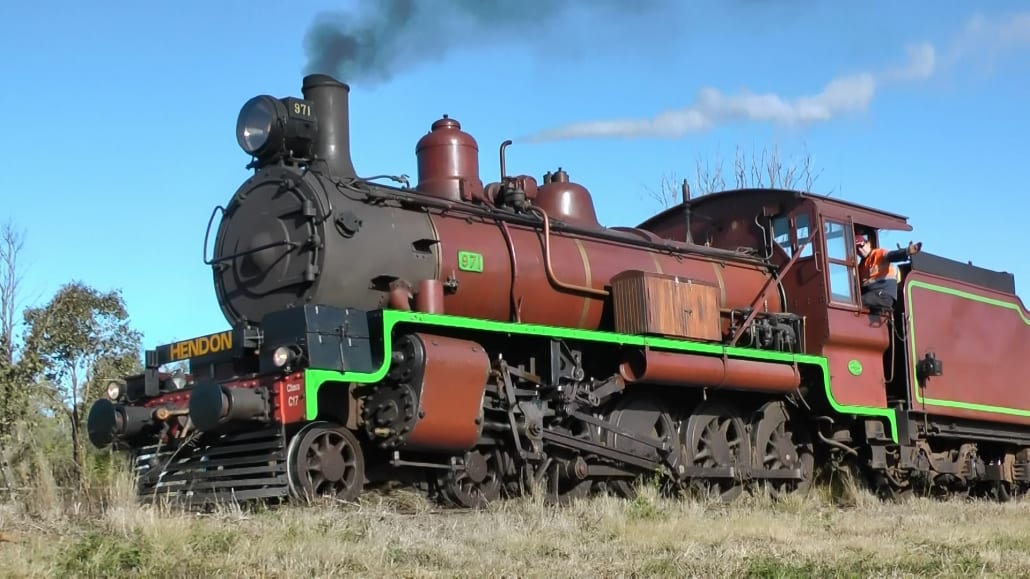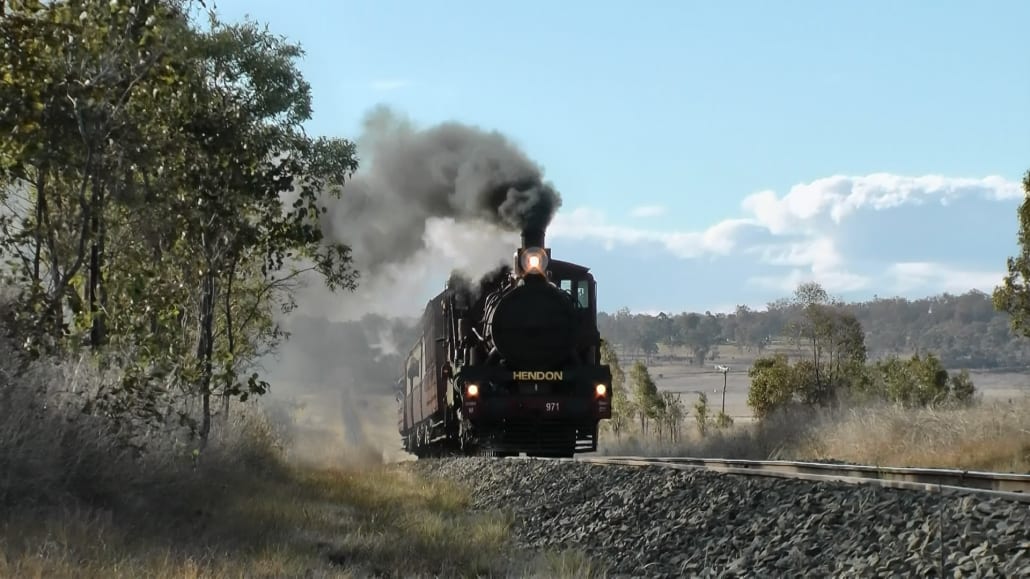Table of Contents
Fast Facts about the Branch
Surveyed: 1884 (Hendon – Allora), 1907-1910 (Allora – Goomburra)
Work started: 1895, 2nd October 1911
Opened: 21st April 1897, 23rd April 1912
Closed: Mothballed 1995, 30th June 1961
Status: Line is currently Closed.
Background
In 1859 the district received its name from the aboriginal word “gnallora,” meaning a waterhole, the “gn” was removed from the name leaving “Allora”.
After the first land sale in 1861, a blacksmith, General merchandise store, general store and a butcher soon began business. Cobb and Co. established a staging station and a small school were opened.
Before the railway was introduced to Allora, there was daily Royal Mail Coach Service between Warwick and the town. It departed Warwick at 5 a.m., and returning every evening at 10.15 p.m. It was also a stopping place for the Royal Mail Coach between Brisbane and Warwick.
In 1869, the railway authorities were exploring the usability of coal that was discovered at Allora. They had used two tons and were asking for two more. It had been used at the Ipswich workshops, and as fuel for the engine in one trip from Ipswich to Dalby. Allora Coal has been pronounced by some to be superior to the best Newcastle coal. No arrangements had yet been made for working the mine but by 1875 two coal mines had been opened between Allora and Hendon. The coal was more suitable for gas production than for coking.
(Warwick Argustus) Saturday, November 13, 1869 – (E&T) – The Coal at Allora. The shaft at Allora is 40 feet deep, and the seam is 3 ft, 6 in thick. The miners opinion that if the shaft was sunk about 40 ft deeper a much thicker and a more valuable seam would be discovered.
The residences of Allora were not pleased when the railway to Warwick bypassed their town by some 6 km to the west in 1871. They had naturally assumed that Allora would be the main intermediate station on the new line. Despite this early setback the local settlers commenced to agitate for a branch line connecting this prosperous agricultural centre with the main line rail head at Hendon. Because of the nature of the black soil country separating the town from the railhead, access was difficult after heavy rain, and the movement of the seasonal grain harvest was often seriously hampered.
During 1874 the construction of a tramway from Hendon to Allora was proposed to the Legislative Committee. It estimated that £3000 was required to defray that expense of this construction. However in 1881, a branch line from Hendon to Allora was suggested and the line was first surveyed in July 1884.
On March 24, 1885, the Warwick Argustus reported that “That the Allora people have declined the tramway with thanks, and have surrendered their claim to a line from Hendon to junction with the via recta at Ross’ Corner.”
On Thursday, October 11, 1888 The Minister for Railways was presented with a petition bearing 250 signatures asking for construction of a branch railway from Hendon to Allora, a distance of between three and four miles. A survey was made some years ago by Mr. Phillips, who estimated then that the cost would be about £6000. The deputation thought it might be estimated at £6,500, including station buildings at Allora. The Minister was reminded of what he was able to see on his recent visit, and also of the fact that Mr. Miles had promised assistance to build a tramway.
Despite steady lobbying, Allora had to wait over two decades before a concrete proposal emerged. Little enthusiasm was held in government circles for the financial prospects of such a short branch line and when the proposal was finally approved in 1895, “guarantee railway” provisions were enacted to ensure the new line met working expenses.
The new line was 3 miles 22 chains in length. There was only one siding, at two miles from Hendon. It was intended to have an engine with carriages and goods van stationed at Allora to work the traffic on the branch. There were to be two trains each way daily.
(Warwick Argustus) Wedneday, April 21, 1897 – The little branch opened for business, the principal contractors, A. Overend and Company, having completed the section for the princely sum of £5,256 ($10,512). The first mixed train trundled down the light track to make the first of many connections with the main line. The contract for the construction of the Allora Station House, platform and Goods Shed was awarded to J. Garget.
Timetable
The time-table was as follows:
| UP TRAINS |
|
|
DOWN TRAINS |
|
|
| Stations |
a.m. |
p.m. |
Stations |
a.m. |
p.m. |
| Allora dep |
11.0 |
2.55 |
Hendon |
11.45 |
3.40 |
| Hendon arr |
11.15 |
3.10 |
Allora |
12.0 |
3.55 |
Allora trains connected with the morning trains from the Border to Brisbane and from Toowoomba to Warwick, and also with the mail train from Sydney to Brisbane. The following rates and fares were charged for traffic sent over the branch, viz:
GOODS.
M, A, and B Classes, per ton…… 1s 8d
Other Classes, per ton …… 2s 6d
LIVE STOCK.
Four-wheeled Wagons, each 2s 6d
Six-wheeled Wagons, each 5s 0d
Eight-wheeled Wagons, each 6s 0d
PASSENGERS.
1st Class – Single, 9d; Return, 1s 2d
2nd Class – Single, 6d; Return, 0s 9d
The Goomburra extension
A decade later, up the fertile valley of Dalrymple Creek beyond Allora, the large pastoral holding “Goomburra” was repurchased by the Government to enable subdivision and disposal to new settlers. The country was particularly well suited to cereal cropping and dairying, and prospects for closer settlement were encouraging indeed.
To foster development of the area, proposals were aired for a branch line extension of the Allora line for some eight miles up the valley. Besides, encouraging growth within the closer settlement area, it was envisage by some that the new line would ultimately be extended to the new Maryvale line in the next valley over the thence via the direct line proposal over the main range to the Fassifern line and Ipswich.
To avoid costly resumptions and disruption in the main town area, the new line was surveyed from the Hendon end of Allora station by way of Darling Street to the town’s eastern outskirts. Despite proposals to relocate the passenger station to the new line, the station at Allora was retained in its original position, necessitating back shunt movements to gain access to and from the new branch. As a further cost cutting measure, ballast was dispensed with and the new track was packed with earth.
The branch line from Allora to Goomburra was officially opened on Friday 23rd August 1912. For this occasion, special trains were run, both from Toowoomba and Warwick, and carried large contingents of passengers from all wayside stations. “
The newspaper of the day says:
“A good proportion of the population of Allora joined the train here – 12 fully laden coaches finally setting out for the run along the magnificent valley, which was looking its best in its garniture of early spring verdure. Unfortunately for all concerned, the heavy train proved too much for the engine on the steep pinch between Kital and Berat, and a double trip to Berat was necessary. So great was the weight of its crowded human freight, that twice on the journey the powerful engine refused its task on the pinches, and as many times the train had to be split in half and hauled along in sections. However, it was a glorious day and a holiday and, despite these delays, Goomburra was reached in good time.”
The opening of the rail link revolutionized life at Goomburra, bringing a daily mail service and a regular shopping link. On Christmas Eve a special train was run from Goomburra to Allora and it was quite a social occasion.
The ceremony of the district was also boosted by the rail link. The timber stands at the top of Goomburra were more easily exploited as the logs were brought to Goomburra Railhead by bullock team and railed to Sharpe’s Mill in Allora. It also resulted in an extension of dairying, as the cream was railed to the Allora Butter Factory. Many thousands of bags of wheat added to the freight railed away.
Stations built on the line
The following names were adopted for the stations at the under mentioned mileages on the Hendon – Allora, Allora – Goomburra line:
| Location |
Miles |
Chains |
Feet above sea level |
| Hendon |
0 |
0 |
1,506 |
| Kates Siding |
2 |
? |
? |
| Allora |
3 |
49 |
1,539 |
| Kital |
6 |
32 |
1,568 |
| Berat |
8 |
21 |
1,654 |
| Kunda |
9 |
74 |
1,688 |
| Goomburra |
12 |
0 |
1,694 |
Description of the line
Laid with 41 lb (19kg) rails in earth and cinder ballast, the branch track was maintained by a single fettling gang based at Allora. For much of the route, the line was unfenced from parallel public roads, and the progress of trains was often slowed by stock grazing on the track. Washaways and gullying often occurred after heavy downpours when black soil from adjacent paddocks would wash onto the tracks. Damage was usually minimal however, and services were rarely disrupted for long.
From Hendon, the line diverged by a triangular junction at the Toowoomba end and passed by the fettler’s cottages and through a patch of poplar box trees before emerging into the wheat paddocks of the Dalrymple Creek valley.
At a motley collection of farm buildings, the line curved to the north, joining the Warwick-Allora back road just south of Kates. With the buildings of Allora clearly in sight, the road was followed, then crossed on the level before the branch’s principle engineering feature, a ten span timber trestle bridge over a black soil gully, was negotiated. Then came Allora’s fixed Distant signal, a level crossing by the butter factory and an ‘S’ curve snaking past the factory and a fuel depot into the station yard. The Distant signal was intended as a warning, as it was necessary for Goomburra trains to back in and out of the station at Allora, at times fouling the Home signal. Allora was the only town of any note served by the line, the population of 900 persons having decreased somewhat in recent years.
Swinging off the main line at the Hendon end of the yard, the Goomburra line struck east along the southern side of a town street. The residence in this part of the town were well used to the sight of a PB15 running along beside the grassy footpath on the twice weekly trip to Goomburra, and cars were parked accordingly. At the eastern end of the street, the New England Highway was joined and followed past the town showground before the paths crossed at an unpretentious open level crossing.
The highway here headed south, with the railway striking east through the wheat paddocks towards the distant peaks of the Great Divide.
Kital was a small shed in the black soil paddocks at an unsealed road crossing, beyond which a short climb ensued at 1 in 44, leading the tracks around a farm on a hill to join the Allora-Goomburra road. This steep inch, although responsible for the downfall of the first train, fell with the loaded wheat trains from Berat and Goomburra and was of little inconvenience, particularly to the little trains of latter years. The line was unfenced from the road the short distance into Berat, comprising the wheat shed, railway station and ganger’s house (which also housed the postal agency and P.M.G. exchange until 1963). A school was located down the valley towards Dalrymple Creek, but closed in 1944.
East of Berat, the Goomburra road was followed as a range of dry hills covered in mountain coolibah and ribbon gum closed in to the south. At one point, the line passed between the road and the front fence of a delightful old ramshackle farmhouse, it’s unpainted walls and fence covered in cactus, flowering creepers and bougainvillea. Just beyond this house was Kunda, a small shed at the base of a dry hill serving nothing in particular. The line’s second bridge of any note was crossed here, a nine span trestle fording a small heavily eroding gully. Another short pinch steepening to a 1 in 40 ensued as the line and road veered around the base of a forested hill passing the site of a ballast pit excavated to supply material during the line’s construction. Once around the hill, the wheat shed at Goomburra loomed in the distance with the pale blue jagged peaks of the Great Divide as a backdrop. The terminus was just short of the village, which comprised a church, hall, school and several houses clustered around the intersection of the two roads leading further up the valley and the road at Gladfield in the next valley over.
Train services and working
Until April 1956, when the branch engine based at Allora was withdrawn, the line enjoyed an extensive train service, particularly on the Hendon leg. Prior to about 1924, the engine and branch crew were based at Goomburra, and worked one daily trip to and from Hendon, and two other daily trips between the junction and Allora. These trips connected with the Wallangarra mail trains and sundry mixed and goods trains on the main line. Although each was technically termed a mixed train, they were in times of low traffic merely engine and van trips catering for passengers, luggage, parcels and light consignments.
In 1924, the engine and crew were transferred from Goomburra to Allora, the service beyond Allora being subsequently reduced to Monday, Wednesday and Friday. The branch engine also squeezed into its hectic day the occasional banking duty assisting a main line train up the demanding Toolburra bank into Hendon.
By 1954, the service between Allora and Hendon had degenerated to a goods train with passenger accommodation only on a daily basis Monday to Saturday, and the branch engine was spending more time in its role as Hendon banker. On Mondays, Wednesdays and Fridays, the engine would run to Goomburra in the morning on the goods train, conveying empty cream cans for distribution at Kital, Berat, Kunda and Goomburra. On the return trip to Hendon, cream was loaded in the cream wagons, which were detached into the butter factory on arrival at Allora, where the crew and engine would retire for a well earned rest. On the off days, when the train did not work out to Goomburra, a single return working to Hendon departing in the morning and leaving for Allora in the afternoon was the norm. Hendon in those days was a lively location, with the branch engine shunting its goods train in the yard while main line goods and mail trains trundled through.
In 1956, this all came to an end when the small out depot of Allora closed and the engine and crew were transferred elsewhere. From Goomburra the line was worked from Warwick based engine and crews, the new train service comprising a return goods train with passenger accommodation to Goomburra on Mondays and Thursdays, and a return run to Allora on Wednesday (also with passenger accommodation and subject to cancellation). During the wheat season, the tri weekly service was augmented by specials, though these mainly terminated at Allora. In 1959, the service to Goomburra was restored for a short time to Monday, Wednesday, Friday running, but this reverted to twice weekly (Monday, Thursday) frequency in 1960.
After the closure of the Goomburra line in 1961, the truncated branch to Allora was served by a twice weekly goods train, at first on Mondays and Wednesdays. Usually worked as a diversion of the Warwick-Toowoomba pick-up train, the Allora train running days were amended on a number of occasions. In 1984, the branch train service was reduced to weekly frequency (Thursday only). With off season loading almost non existent, the operation of train services into Allora on a regular basis would seem to be somewhat unwarranted and pruning of this remaining service was highly likely.
Prior to 1961, PB15s and B15s were the main engine used on the branch. Following strengthening of the 10 span bridge between Hendon and Allora, main line engines were permitted to work the branch, diesels being introduced in 1966. In 1970, the operation of trains without the brake van in rear was permitted; the weekly goods train usually towed back to Hendon after running up to Allora in the usual order. Grain specials continued to run during the season, commonly from Toowoomba running to and from the branch via the northern leg of the Hendon fork line. At times, main line trains work a switch trip to Allora to clear the silo. When the wheat is moving, things can be quite hectic, as evidenced by the activity on Thursday, 17th September, 1981, when two special grain trains operated into Allora in addition to the regular goods train.
Up until the closure of the Goomburra extension, the line was worked as two ordinary sections as follows:
Hendon – Allora
Allora – Goomburra
Nothing fancy was provided in the way of signaling. Allora being protected by a fixed Up Distant signal and Up Home signal, with a Down Home signal on the Goomburra branch. Goomburra had no signals whatsoever.
Closure of the line
Following the construction of the direct highway through Cunningham’s Gap in the 1930s, the effects of road competition were felt in the Allora district rather early in the piece. By the new road, Allora was brought within 160 km of Brisbane, about fifty miles less than the corresponding distance by rail. Goomburra was even more seriously placed, and traffic slowly leaked away towards other transport modes. The crunch came on 30th June, 1961, when the train service ceased altogether beyond Allora. Local road carriers quickly took over the cream transport and the branch rails languished in the weeds and grass until they were removed in late 1961. You can still make out the alignment, but no rail infrastructure remains.
Following this closure, the Goomburra settlement has declined even further, with the destruction of the school by fire in 1971 and closure of the postal agency in 1981.
The Hendon to Allora section remained open until 1995 when it was mothballed by Queensland Rail. In Christmas 2010, the bridge outside Allora has the approaches washed away by flood waters. Since this time no work has been completed on the line and the future remains uncertain.
More Images






